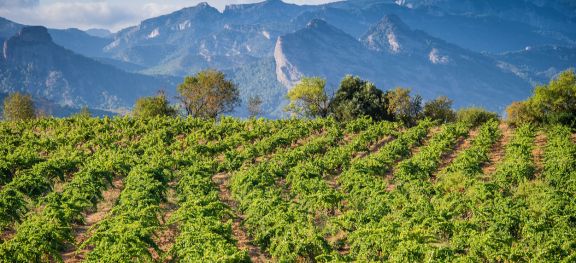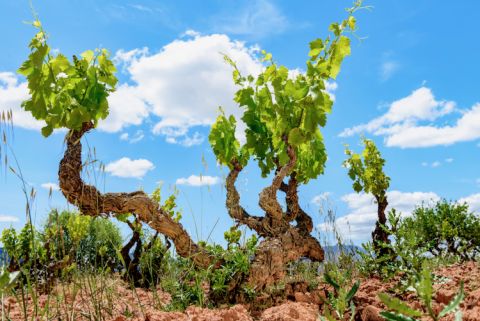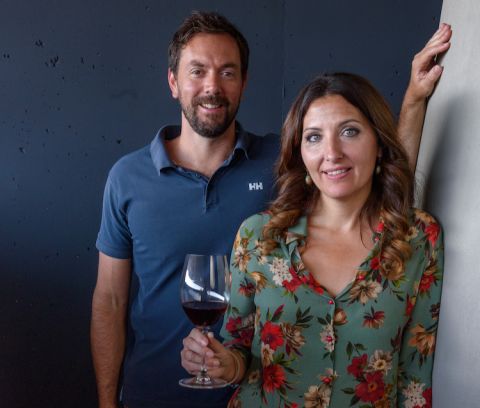Herència Altés Garnatxa Blanca 2022 Terra Alta

A superb-value organically grown white wine from high-elevation vineyards in Spanish Cataluña.
From €7.50, £11.50, $13.98
I came across this wine at the recent Wine Society tasting in London and immediately earmarked it as a possible wine of the week, so impressive was it in terms of quality, price and unadulterated pleasure.
The wine may be full of pure citrus and pear-like fresh-fruit aromas and flavours yet it is much more than this, with a firm texture from three months on the lees after spontaneous fermentation (ie no added yeasts) in stainless-steel tanks, with lees stirring to create a more full-bodied wine that is nevertheless deliciously fresh. The acidity and the creamy texture give the wine shape and structure, turning something seductively fruity into something serious, with complexity that is notable for a wine at this price. The alcohol is a perfectly balanced 13%.
It’s made entirely from Garnatxa Blanca, as Garnacha Blanca is known in Cataluña, organically certified, produced from their own younger vines (less than 20 years old) and from older vines that they rent. (Many of their own vines were planted in the early and mid 20th century and do not provide sufficient fruit for this wine.) All the vineyards are grown at a cool 420–500 m (1,378–1,640 ft) above sea level in Batea and Gandesa in Terra Alta.
Terra Alta, Cataluña’s most southerly appellation, south-east of Barcelona, is named for its elevation, its ‘high land’, and apparently produces one-third of the world’s Garnacha Blanca. The region’s total vineyard area of 5,820 ha (14,382 acres) in 2020 is focused mainly on Garnachas, both red and white.
As I have not yet visited Terra Alta, I asked our Spanish expert Ferran Centelles for his impressions of the region. As well as being enthusiastic about the investments being made at Herència Altés (eg new concrete tanks and Stockinger foudres in the winery), he told me that near the winery is his favourite spot in Terra Alta, the Coll del Moro, an Iberian settlement site that dates back to 600 BCE. ‘What sets it apart is the preservation of a large tower at the highest point of the enclosure, a witness to its moment of greatest splendour,’ he writes. ‘But that's not all. In the site, there are the remains of an ancient Iberian proto-winery.’
Herència Altés, meaning 'Altés Heritage', was created in 2010 by Núria Altés and her English–Spanish husband Rafael De Haan, with the idea of making wine from the 6 ha (15 acres) of vines owned by Núria’s family (the grapes used to go to the local co-operative). They made substantial vineyard purchases in 2013 and 2015 so that they now own 50 ha (148 acres) and rent a further 10 ha, including those original family vines.
They specialise in the drought-resistant Garnatxa Blanca, which copes well with an average annual rainfall of 400 mm (16 in). They have been farming organically since 2015 and were certified in 2018. Their full-time winemaker Gerard Mercadé has been supported since 2014 by consultant winemaker Claude Gros. One of Gros's recommendations was to deliberately oxidise the juice. This removes any bitter phenolics from the skins but also means the wine does not need heavy fining or filtration, hence the texture of the finished wine.
The vineyards benefit from a warm, dry climate that it cooled by the south-easterly wind from the sea, which also brings humidity, and by the dry north-westerly wind that helps protect the vines from fungal diseases (particularly helpful if you farm organically). The mountains between Terra Alta and the sea protect their vineyards from extreme storms. Thanks to the elevation of the vineyards, there is a big diurnal temperature range: daytime summer temperatures can reach 38 °C (100 °F) but usually drop to around 20 °C (68 °F) at night, which is an important factor in maintaining freshness in the wine and in being able to harvest fully ripe grapes while avoiding high alcohol levels. The soils are sandy and chalky over clay-limestone and there’s good water provision for the vines thanks to the water-holding capacity of the limestone bedrock.
As well as farming organically and promoting healthy soils, they are working to preserve biodiversity on their land via a rewilding project. This includes rebuilding stone walls, which helps prevent soil erosion and, De Haan explains, creates ‘a multitude of habitats for repopulating our vineyards with insectivores and other predators, lizards, birds, bats. These animal populations help control pests that would otherwise be treated by spraying insecticides under conventional farming.’
Herència Altés have been members of International Wineries for Climate Action since 2021. Their strategies to reduce their carbon footprint include producing 80% of their energy needs from solar panels, the use of electric vehicles in the vineyards, planting thousands of native plants and trees and installing nesting boxes for insect-eating birds. Their bottles are a wonderfully light 395 g (1,143 g when full).
I haven’t had the opportunity to try this wine at the table but the Herència Altés website suggests pairing the wine with traditional local tapas from the River Ebro area, for example cuttlefish, baby squid and steamed mussels.
The wine is imported into the US by European Cellars (Eric Solomon Selections) and is widely available, with a recommended retail price of $15.
The UK importer is Bancroft Wines, who tell me it is one of their most widely distributed wines. Retailers include Mayfair Wines, Street Wines, Rothbury Wines, Tivoli Wines, Vin Neuf, Padstow Wine Company, Sevenoaks Wine Merchants, The Offy Whitstable, The Horsham Cellar, VINVM, Yorkshire Vintners, The Wine Society, Cobbs Farm Shops, Dulwich Vintners, Ellis Wharton Wines, The Framlingham Wine Shop, Dalling & Co. Wines, Weavers of Nottingham, Berry Grape & Grain, etc). It is also available from the producer’s website for €9.90.
European Cellars noted that some retailers are still selling the 2021. I asked De Haan to compare the vintages as I had not tasted the 2021. ‘Although very similar, the 2022 is slightly riper and lower in acidity, due to harvest conditions. It also benefited from lees stirring. In my view, the 2021 is now in a wonderful place, with a greater aromatic expression and creaminess than the 2022, due to some bottle age. Our whites can be a bit discreet in their infancy due to how we handle the skins and the must.’
The 2022 is already delicious but it’s worth buying more than one bottle and keeping the second (if you have somewhere relatively cool) for another year to see how it develops.
Members can find reviews of many more wines from Terra Alta in our tasting notes database.
Become a member to view this article and thousands more!
- 15,416 featured articles
- 274,315 wine reviews
- Maps from The World Atlas of Wine, 8th edition (RRP £50)
- The Oxford Companion to Wine, 5th edition (RRP £50)
- Members’ forum
- 15,416 featured articles
- 274,315 wine reviews
- Maps from The World Atlas of Wine, 8th edition (RRP £50)
- The Oxford Companion to Wine, 5th edition (RRP £50)
- Members’ forum
- Commercial use of our Tasting Notes





